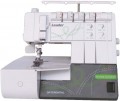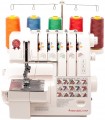Type of sewing machine
The type of sewing machine determines its functionality and specific application.
—
Electromechanical. The classic, most simple kind of sewing machines: they do not have computer control, all work parameters are adjusted mechanically, and the use is limited to the simplest types of seams.
—
Computerized. Sewing machines are equipped with built-in computers that control the sewing process. Because of this, they have a more extensive feature set and are more accurate in settings than electromechanical ones, although they cost accordingly. Note that only computerized sewing machines are meant; embroidery and sewing-embroidery machines are separated into separate categories (see relevant paragraphs).
—
Embroidery. Such machines were originally intended only for embroidering patterns, and are practically not suitable for work outside this specialization (ordinary sewing, hemming). They have the appropriate design features, are equipped with embroidery hoops and feet for embroidery, are often equipped with both a set of built-in presets (for example, embroidering letters of the alphabet), and can connect to a PC and download patterns.
—
Sewing and embroidery. Machines that can be used for both sewing and embroidery. In terms of design and sewing capabilities, they are similar to computerized models (see t
...he relevant paragraph) but are supplemented with an embroidery unit, hoops and other embroidery equipment. And the built-in features usually include basic embroidery elements (crosses, stars, satin stitch, etc.), as well as the ability to embroider according to patterns downloaded from a computer. Such machines are very versatile, but in terms of specific capabilities, they may be inferior to more specialized models.
— Overlocker. A special type of sewing machine designed primarily for seaming and trimming the edges of materials. Overlocker overcasts the edge of the fabric with a special seam, which prevents fraying, shedding and deformation. One of the design features of such devices is the presence of several working threads, from 2 to 10 (most often 3 or 4).
— Coverstitch. Devices designed to create cover stitch — a flat, stretchy seam that is most commonly used for hemming a folded edge in knitwear, as well as in some types of joins. For other purposes, such machines are not used.
— Coverlock. Devices that combine an overlocker and a coverstitch machine in one case. For more information about each of these varieties, see the relevant paragraph. Here we note that the coverlock is a universal tool for processing edges: it can overcast them, cut off the excess fabric and hem the folded edge with a cover stitch. In addition, many modern coverlock are also capable of seaming materials (mainly with a double chain stitch).Number of stitches
The number of stitches that a sewing machine can sew. The larger this number, the more extensive the capabilities of this model, the wider the choice the user has; however, it wouldn’t hurt to clarify the specific range of supported stitches separately.
The fewest options - mostly up to 25 - are provided in electromechanical machines, as well as specialized devices such as overlockers and carpet lockers (see “Type”). In computer-controlled devices, the number of lines can be in the dozens, and some also allow you to download additional options from the computer.
Max. stitch length
The maximum stitch length that the sewing machine can sew. This parameter is important for working with dense thick fabrics: the stronger the fabric, the longer the seam used for it. Accordingly, the longer the stitch (
5 mm or more), the better the machine is suitable for working with similar fabrics.
Max. stitch width
The maximum stitch width provided by a sewing machine.
Most modern sewing machines are capable of working not only with the simplest longitudinal seam (when punctures with a needle occur strictly one after another), but also with seams that cover a certain width - for example, zigzag and various decorative ones. And in overlockers, such opportunities are generally available by definition.
The larger the maximum stitch width, the correspondingly wider the machine’s ability to work with specific types of seams (all other things being equal). An indicator of up to 5 mm is typical mainly for entry-level devices, 5 - 7 mm - average, 7 mm and more - advanced.
Max. presser foot height
It is the distance from the work surface to the presser foot in the highest position. It must be taken into account when working with thick fabrics.
Power consumption
The power consumed by the machine during operation. Usually, the maximum power value is indicated in the characteristics.
Most of the electricity supplied to the machine is consumed by the engine, so this indicator primarily describes the power of the engine. The higher this power, the faster the machine can work and the better it is suitable for working with dense fabrics. However, there is no strict dependence here, much also depends on the general specialization of the unit.

